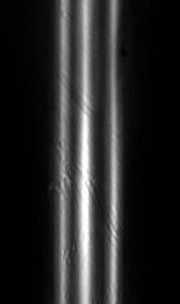Abstract:
PCB motors seems suited for laser scanning;
- speeds seem sufficient
- cross scan error is not affected by pcb coils
Angular stability needs to be improved but this is seen a relatively trivial issue.
Video:
I changed my sliding bearing with the one from a BLDC motor extracted from a laser printer and redid the measurement. This did not improve the results.
I moved to a prism which I used to make the pcb shown on this webpage.
An exposure result is shown below;

An earlier measurement with the BLDC motor can be found here.
Earlier I measured a cross scan error of 115 microns, at a distance of 30 mm. Now I measure a cross scan error of 162 microns at a distance of 40 mm. I expected an error of 4/3*115=153 microns, a difference of 6 percent.
The facet lines are stable over time. I do not see any vibrations or movement introduced into the prism exposure (dynamic scan error). The scan error seems static, related to imperfections in the prism or mounting.
I therefore conclude that PCB motors are suited for laser scanning;
- speeds seem sufficient
- cross scan error is not affected by PCB coils
I will move on to improving and testing the angular stability of the PCB motor.
 Hexastorm
Hexastorm
Discussions
Become a Hackaday.io Member
Create an account to leave a comment. Already have an account? Log In.
Thanks @gravis, I simple mean that the rotor has to rotate at a constant speed. I expect this to be easier at high speeds as kinetic energy is quadratic and work by friction is linear for low speeds. If the rotor is really stable a photodiode might not be needed.
Are you sure? yes | no
In the event that the rotational velocity is not as stable as you wish then you may want to consider radically increasing the number of coils, making them as thin as possible, and using the smallest round magnets easily available. I believe the weaker but more frequent EM bursts would result in smoother operation.
The script that calculates generated EM fields should be useful in finding a more optimal coil shape to push against the EM field of the magnets in a more uniformly fashion. Matching the coil EM field shape to evenly push against the magnet EM field should increase overall efficiency and therefore (as the video you posted points out) the torque.
Are you sure? yes | no
I'm glad the PCB coils worked out!
As for angular stability (which I assume is about wobbling on the spinning axis), you may consider investigating if switching to a different motor driver impacts the stability.
Are you sure? yes | no